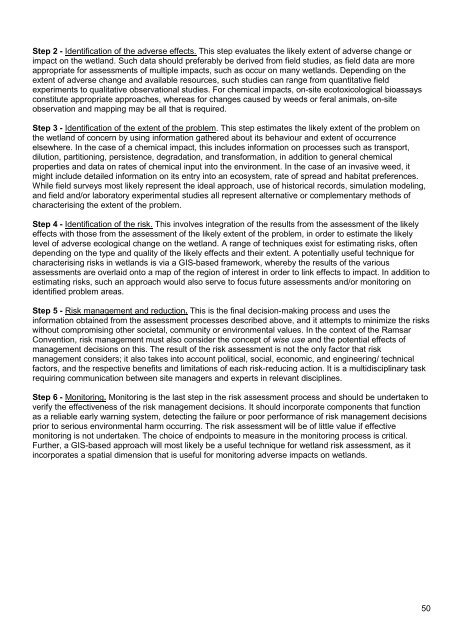2007 Wetland Inventory for the Eyre Peninsula
2007 Wetland Inventory for the Eyre Peninsula
2007 Wetland Inventory for the Eyre Peninsula
- No tags were found...
Create successful ePaper yourself
Turn your PDF publications into a flip-book with our unique Google optimized e-Paper software.
Step 2 - Identification of <strong>the</strong> adverse effects. This step evaluates <strong>the</strong> likely extent of adverse change orimpact on <strong>the</strong> wetland. Such data should preferably be derived from field studies, as field data are moreappropriate <strong>for</strong> assessments of multiple impacts, such as occur on many wetlands. Depending on <strong>the</strong>extent of adverse change and available resources, such studies can range from quantitative fieldexperiments to qualitative observational studies. For chemical impacts, on-site ecotoxicological bioassaysconstitute appropriate approaches, whereas <strong>for</strong> changes caused by weeds or feral animals, on-siteobservation and mapping may be all that is required.Step 3 - Identification of <strong>the</strong> extent of <strong>the</strong> problem. This step estimates <strong>the</strong> likely extent of <strong>the</strong> problem on<strong>the</strong> wetland of concern by using in<strong>for</strong>mation ga<strong>the</strong>red about its behaviour and extent of occurrenceelsewhere. In <strong>the</strong> case of a chemical impact, this includes in<strong>for</strong>mation on processes such as transport,dilution, partitioning, persistence, degradation, and trans<strong>for</strong>mation, in addition to general chemicalproperties and data on rates of chemical input into <strong>the</strong> environment. In <strong>the</strong> case of an invasive weed, itmight include detailed in<strong>for</strong>mation on its entry into an ecosystem, rate of spread and habitat preferences.While field surveys most likely represent <strong>the</strong> ideal approach, use of historical records, simulation modeling,and field and/or laboratory experimental studies all represent alternative or complementary methods ofcharacterising <strong>the</strong> extent of <strong>the</strong> problem.Step 4 - Identification of <strong>the</strong> risk. This involves integration of <strong>the</strong> results from <strong>the</strong> assessment of <strong>the</strong> likelyeffects with those from <strong>the</strong> assessment of <strong>the</strong> likely extent of <strong>the</strong> problem, in order to estimate <strong>the</strong> likelylevel of adverse ecological change on <strong>the</strong> wetland. A range of techniques exist <strong>for</strong> estimating risks, oftendepending on <strong>the</strong> type and quality of <strong>the</strong> likely effects and <strong>the</strong>ir extent. A potentially useful technique <strong>for</strong>characterising risks in wetlands is via a GIS-based framework, whereby <strong>the</strong> results of <strong>the</strong> variousassessments are overlaid onto a map of <strong>the</strong> region of interest in order to link effects to impact. In addition toestimating risks, such an approach would also serve to focus future assessments and/or monitoring onidentified problem areas.Step 5 - Risk management and reduction. This is <strong>the</strong> final decision-making process and uses <strong>the</strong>in<strong>for</strong>mation obtained from <strong>the</strong> assessment processes described above, and it attempts to minimize <strong>the</strong> riskswithout compromising o<strong>the</strong>r societal, community or environmental values. In <strong>the</strong> context of <strong>the</strong> RamsarConvention, risk management must also consider <strong>the</strong> concept of wise use and <strong>the</strong> potential effects ofmanagement decisions on this. The result of <strong>the</strong> risk assessment is not <strong>the</strong> only factor that riskmanagement considers; it also takes into account political, social, economic, and engineering/ technicalfactors, and <strong>the</strong> respective benefits and limitations of each risk-reducing action. It is a multidisciplinary taskrequiring communication between site managers and experts in relevant disciplines.Step 6 - Monitoring. Monitoring is <strong>the</strong> last step in <strong>the</strong> risk assessment process and should be undertaken toverify <strong>the</strong> effectiveness of <strong>the</strong> risk management decisions. It should incorporate components that functionas a reliable early warning system, detecting <strong>the</strong> failure or poor per<strong>for</strong>mance of risk management decisionsprior to serious environmental harm occurring. The risk assessment will be of little value if effectivemonitoring is not undertaken. The choice of endpoints to measure in <strong>the</strong> monitoring process is critical.Fur<strong>the</strong>r, a GIS-based approach will most likely be a useful technique <strong>for</strong> wetland risk assessment, as itincorporates a spatial dimension that is useful <strong>for</strong> monitoring adverse impacts on wetlands.50
















